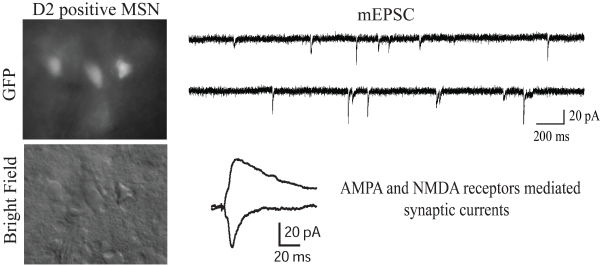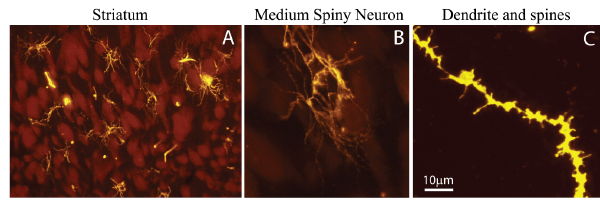
Veronica A. Alvarez, PhD, Acting Chief
and Tenure-Track Investigator
Section on Neuronal Structure (SNS)
Laboratory for Integrative Neuroscience (LIN) NIAAA / NIH
5625 Fishers Lane, Room TS-24, MSC9411
Bethesda, MD 20892-9411
Office: (301) 443-7695
Lab: (301) 443-3769
Fax: (301) 480-0466
E-mail: alvarezva@mail.nih.gov
Mission statement
Experiments in the laboratory are aimed at understanding the acute and chronic actions of drugs of abuse on neurons and neuronal circuits. Chronic cocaine exposure triggers persistent changes in the morphology of neurons and synapses in specific regions of the brain such as the nucleus accumbens and prefrontal cortex1,2. The mechanisms by which cocaine leads to these changes are not well understood and they are part of the goal of our studies. In addition, we are focused on understanding the functional consequences associated with the morphological changes at synapses.
One salient characteristic of addiction is that not every person exposed to drugs of abuse becomes an addict. For example, only 20% of cocaine users become compulsive drug-takers3. Similarly, only a fraction of research animals that self-administer cocaine show addiction-like behaviors4. One important part of our research is focused on understanding what is different in the brain of animals that developed addictive behaviors. Understanding the changes in the brain that contribute to compulsive drug taking and the vulnerability factors of becoming an addict are crucial for improving treatment and prevention of this disease.
Research projects
We are addressing three specific questions:
- How does chronic exposure to cocaine and ethanol affect the structure and function of neurons and synapses?
- What is different in the brain of subjects exposed and addicted when compared to those exposed but non-addicted?
Is there a difference in synaptic function and morphology between animals that display addictive-like behaviors and animals that do not after they all have been chronically exposed to cocaine or ethanol?
- Are there differences in the function and morphology of synapses in animals with higher predisposition to become addicted to cocaine?
To answer these questions, we use a combination of techniques: electrophysiology, 2-photon laser scanning microscopy, biochemistry and behavior. Whole cell voltage clamp recording from medium spiny neurons (MSN) of the nucleus accumbens and the striatum are performed in order to determine the functional properties of the synaptic inputs onto D2-positive neurons and D1-positive neurons.

We are also studying the morphological changes associated with chronic cocaine and with the development of addictive behaviors by fluorescently labeling MSN using ballistic methods and imaging spine morpholgy with confocal and 2-photon microscopes.

Findings from these studies will provide information about the short-term and long-term effects of drug of abuse, such as cocaine and alcohol, on synapses. In addition, we hope they will lead to the identification of neuronal markers associated with higher vulnerability to addiction and they will aid in the development of new therapies.
Lab Members
Selected Publications
V.A. Alvarez, D.A. Ridenour and B.L. Sabatini. (2007). Distinct Structural and Ionotropic Roles of NMDA Receptors in Controlling Spine and Synapse Stability. J. Neurosci. 28:7365-76.
V.A. Alvarez and B.L. Sabatini. (2007) Anatomical and physiological plasticity of dendritic spines. Annu. Rev. Neurosci. 30:79-97.
V.A. Alvarez, D.A. Ridenour and B.L. Sabatini. (2006). Retraction of synapses and dendritic spines induced by off-target effects of RNA interference. J. Neurosci. 26: 7820-5
S.F. Tavazoie*, V.A. Alvarez*, D.A. Ridenour, D.J. Kwiatkowski, B.L. Sabatini (2005). Regulation of neuronal morphology and function by the tumor suppressors Tsc1 and Tsc2. Nat Neurosci. 8, 1727-34
V.A. Alvarez, C. Chow, E.J. Van Bockstaele and J.T. Williams. (2002). Frequency-dependent synchronization of locus coeruleus neurons: role of electrotonic coupling. Proc Natl Acad Sci U S A. 99: 4032-6
V.A. Alvarez*, S. Arttamangkul*, J. Whistler, M. van Zastrow, D. Grandy and J.T. Williams. (2002). J Neurosci. 22: 5769-76.
V.A. Alvarez, S. Arttamangkul, and J.T. Williams. (2001). A RAVE about Opioid Withdrawal. Neuron 32: 761-763. New and Views.
V.A. Alvarez, Maubecin, F. Garcia-Hernandez, J.T. Williams and E. Van Bockstaele. (2000). Functional coupling between neurons and glia. J. Neurosci. 20: 4091-4098.